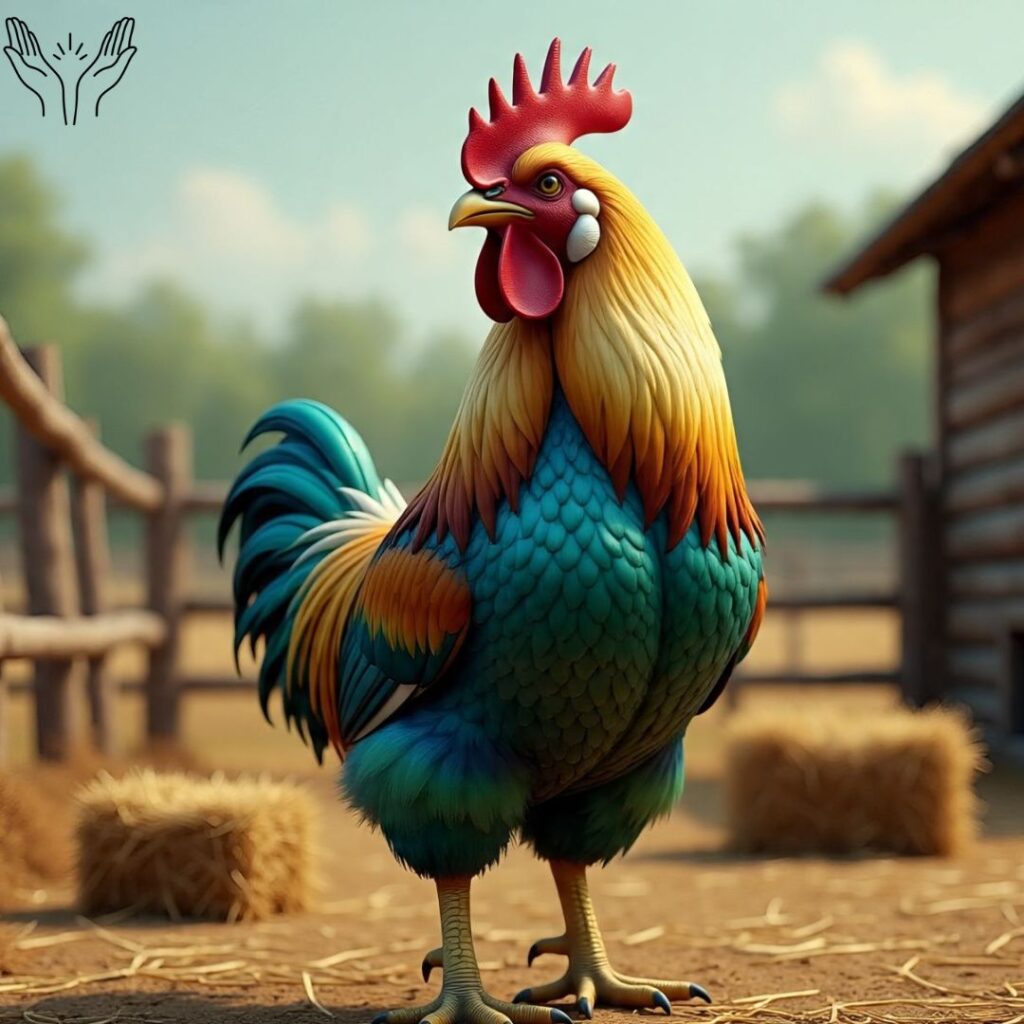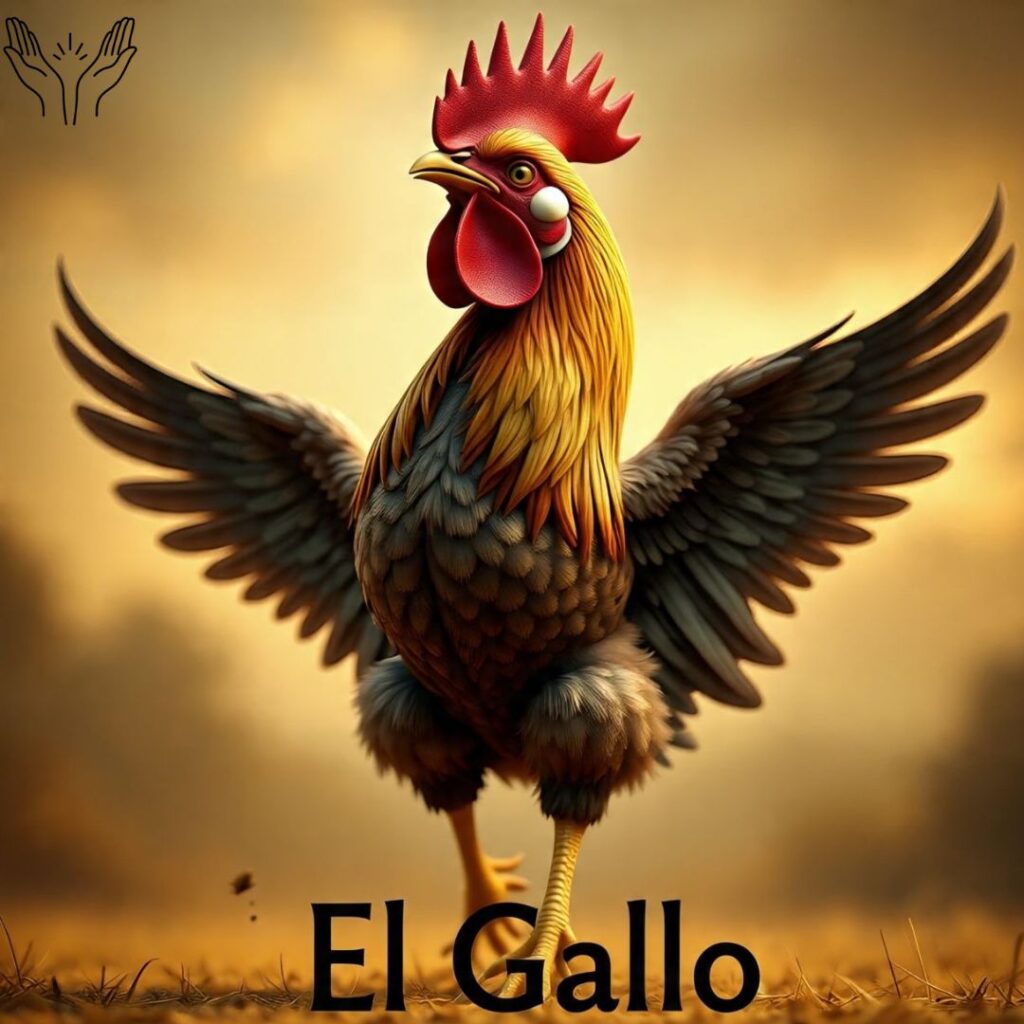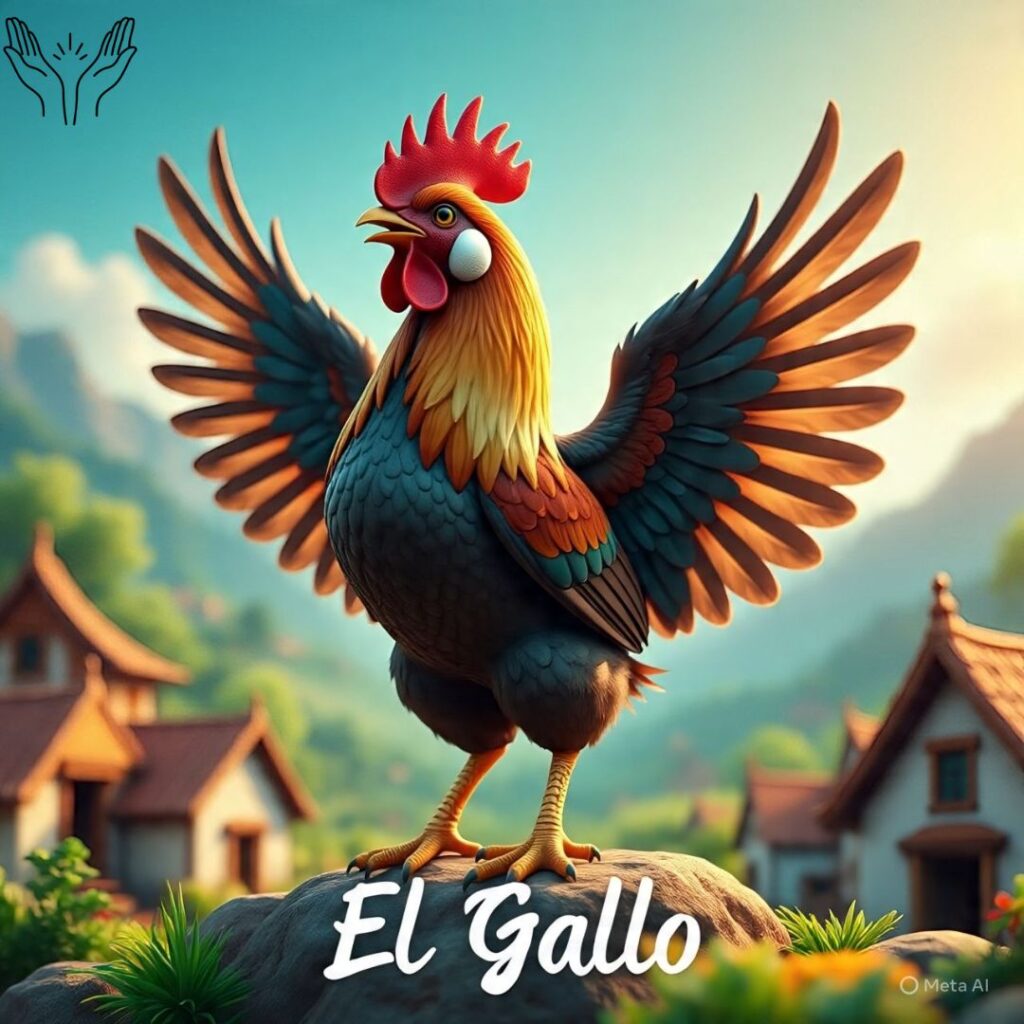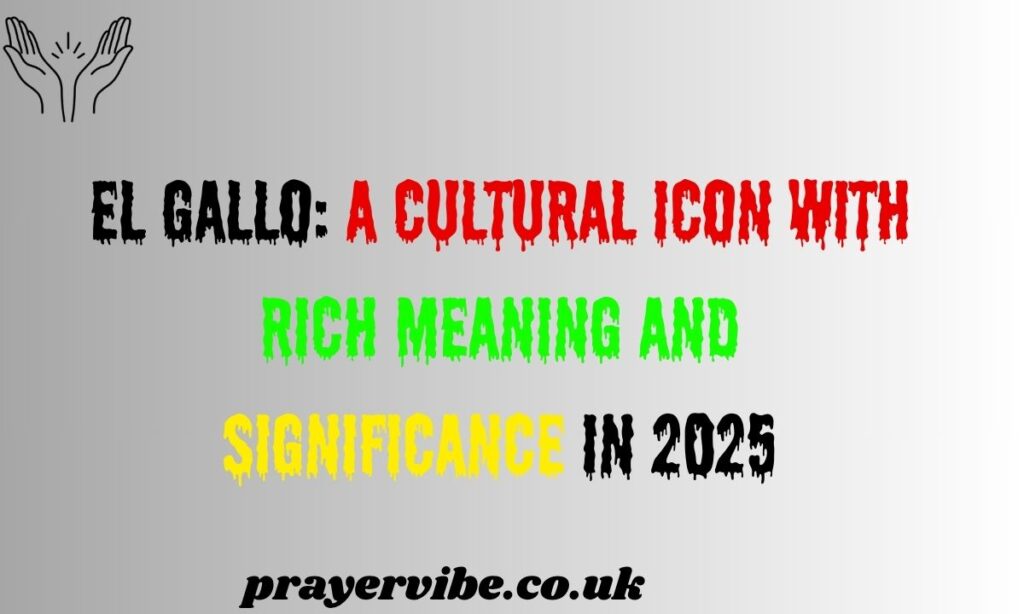Welcome! If you’ve ever encountered the vibrant and powerful image of a rooster, or “El Gallo,” and wondered about its profound meaning, you’ve come to the right place.
El Gallo is far more than just a barnyard bird; it’s a cultural phenomenon that carries deep symbolism, historical significance, and holds a cherished place in Latin American traditions and beyond.
In this comprehensive exploration, we’ll uncover why El Gallo continues to captivate hearts and minds in 2025. We’ll journey through its historical origins, examine the rich symbolism it embodies, and discover how it’s celebrated and honored in contemporary times.
Literal Meaning of “El Gallo”

At its foundation, “El Gallo” offers a straightforward translation “The Rooster” in English. However, this simple definition barely scratches the surface of its true depth.
What Does “El Gallo” Mean?
In Spanish, “gallo” is the common term used to describe a rooster or male chicken. It’s intrinsically connected with the break of dawn, the piercing morning crow, and the herald of a fresh day’s beginning.
In rural communities throughout Spanish-speaking regions, roosters have served as essential companions to daily life for countless generations, acting as natural timekeepers and embodying principles of vigilance, discipline, and reliability.
Phonetic Breakdown:
- El Gallo: [el gah-yo]
- The pronunciation may vary slightly across different Spanish-speaking regions, reflecting local accents and dialectal variations.
While “el gallo” directly refers to the bird itself, it frequently carries profound meanings that extend into various symbolic, cultural, and spiritual contexts that have evolved over centuries.
Symbolism and Cultural Significance of El Gallo
Roosters have maintained symbolic importance across diverse cultures, with particular prominence in Spanish-speaking communities. The term “El Gallo” transcends its literal animal reference, embodying fundamental values of strength, courage, honor, and spiritual awakening.
The Rooster as a Symbol of Strength and Courage
In Spanish culture, the rooster has long been a symbol of masculinity, power, and pride. The rooster’s crowing at dawn signifies a new beginning, a call to action, and often, a declaration of readiness for a challenge. Its natural role as a defender and fighter in the animal kingdom reinforces its symbolism of resilience, tenacity, and unwavering determination.
Rural societies have depended on roosters for centuries, viewing them as symbols of vigilance, discipline, and reliability. The bird’s role extends beyond mere timekeeping to encompass broader concepts of leadership and protective guardianship within agricultural communities.
“El Gallo” in Folklore and Proverbs
The rooster features prominently in Spanish folklore and traditional wisdom through countless proverbs and sayings. These time-honored expressions reveal deep cultural insights:
- “El gallo que canta no pelea.” (The rooster that sings does not fight) – This profound saying suggests that those who boast loudly or make excessive noise are often not the ones who demonstrate true effectiveness or courage when action is required.
- “Cuando el gallo canta, la hora está marcada.” (When the rooster crows, the hour is marked) – This proverb emphasizes the rooster’s crow as a dependable signal, symbolizing punctuality, precision, and the natural order of time.
- “Al gallo que canta le tuercen el pescuezo.” (The rooster that sings gets its neck twisted) – A cautionary saying about the dangers of being too vocal or drawing unwanted attention.
These traditional phrases underscore the rooster’s deep connection to concepts of time, vigilance, wisdom, and disciplined behavior in everyday life.
The Awakening of New Beginnings
The rooster’s crowing marks the arrival of dawn, a time of renewal and opportunity. In Mexican culture, the rooster represents hope and the promise of a new day, signaling that despite yesterday’s struggles, today brings fresh chances and clarity. This symbolism of renewal and fresh starts makes El Gallo a powerful metaphor for personal transformation, spiritual awakening, and the endless cycle of hope.
“El Gallo” in Popular Culture
The term “El Gallo” enjoys a prominent and celebrated role in music, literature, cinema, and media, particularly throughout Latin American and Mexican cultures, where it has become an enduring symbol of cultural identity.
Music and Songs: The Rooster in Latin Music
One of the most iconic songs featuring “El Gallo” is the legendary “El Gallo de Oro” (The Golden Rooster), a classic ranchera song performed by the beloved Mexican singer Vicente Fernández. This song has become an anthem of Mexican pride and cultural identity.
The song’s powerful lyrics portray a proud and unyielding character who embodies the fierce and spirited nature of the rooster itself. In this musical context, the rooster symbolizes a brave individual—someone who confronts life’s challenges head-on with unwavering confidence and deep-rooted pride.
Famous Lyrics from “El Gallo de Oro”: “Yo soy el gallo de oro, el que no le teme a nadie.” (I am the golden rooster, the one who fears no one.)
In Spanish folk music, boleros, and mariachi traditions, the rooster frequently appears as a symbol of pride, fearlessness, and cultural heritage. It serves as a powerful metaphor describing individuals who remain unyielding in pursuing their dreams and goals, regardless of obstacles.
“El Gallo” in Literature and Cinema
From the golden age of Mexican cinema to contemporary literature, the rooster appears as a central figure in countless artistic works. In Mexican literary traditions, the rooster represents not merely nature’s influence, but embodies community spirit, survival instincts, and cultural continuity.
In cinema, particularly in classic Mexican films, the rooster is frequently depicted as a symbol of heroism, courage, and resilience—themes that resonate deeply in a culture where struggle, perseverance, and survival are recurring motifs in storytelling. The rooster’s presence in these narratives often signals themes of redemption, honor, and the triumph of the human spirit.
Contemporary artists and filmmakers continue to draw upon El Gallo’s rich symbolism, incorporating it into modern works that explore themes of identity, cultural pride, and social justice.
“El Gallo” in Mexican Cuisine
No comprehensive discussion of “El Gallo” would be complete without exploring its significant role in Mexican culinary traditions. Roosters serve not only symbolic functions but also play an important practical role in traditional Mexican cooking and festive celebrations.
Rooster Dishes in Mexico
One of the most celebrated dishes featuring rooster is Gallo en Mole, a traditional Mexican delicacy that showcases rooster meat simmered in rich, complex mole sauce. This dish is particularly popular during festive occasions and represents the hearty, robust flavors that define authentic Mexican cuisine.
Gallo en Mole Recipe (Traditional Method):
- Ingredients: Fresh rooster meat, authentic mole paste, rich chicken stock, white onions, fresh garlic, toasted sesame seeds, Mexican chocolate, and traditional spices.
- Preparation: The rooster is slowly cooked in a deep, savory mole sauce crafted from carefully roasted chiles, aromatic spices, nuts, seeds, and Mexican chocolate, creating a dish that embodies centuries of culinary tradition and cultural heritage.
Other popular rooster dishes include Caldo de Gallo (rooster soup), Gallo Guisado (stewed rooster), and Pozole de Gallo, each representing different regional cooking styles and family traditions.
Festivals and Rooster Feasts
In rural Mexican regions, the rooster is often slaughtered for large feasts during family gatherings and festivals. This culinary tradition ties into the rooster’s symbolism of fertility, strength, and prosperity. These communal celebrations strengthen family bonds and preserve cultural heritage through shared meals and storytelling.
El Gallo plays a central role in these community celebrations, where the bird is honored both for its exceptional flavor and its deep representation of cultural heritage, family unity, and abundance.
El Gallo in Mexican Wrestling (Lucha Libre)
In the colorful and dramatic world of Mexican wrestling, known as Lucha Libre, roosters serve as powerful metaphors for the fighters themselves, embodying the sport’s emphasis on courage, spectacle, and cultural pride.
Mascot and Symbol of Fighters
In Lucha Libre culture, wrestlers frequently adopt animal personas to connect with audiences and embody specific characteristics. The rooster, with its naturally fierce disposition and fighting spirit, represents an ideal choice for wrestlers seeking to portray courage, combativeness, and readiness to face any opponent, regardless of the odds.
The rooster persona allows wrestlers to tap into deep cultural symbols that resonate with Mexican audiences, creating emotional connections that transcend mere athletic competition.
Iconography in Lucha Libre
Legendary wrestlers such as El Gallo and El Gallo Negro (The Black Rooster) have embraced the complete symbolism of the rooster in their elaborate masks, colorful costumes, and ring personas. These performers portray themselves as proud, fearless characters who draw direct inspiration from the animal’s natural resilience, territorial dominance, and fighting instincts.
The rooster iconography in Lucha Libre includes intricate mask designs featuring rooster combs, elaborate feathers, and vibrant colors that reflect the bird’s natural beauty and fierce spirit.
“El Gallo” as a Metaphor

Beyond its literal and symbolic roles, “El Gallo” functions as a powerful metaphor in everyday Spanish language and cultural expressions, extending its influence into daily communication and social interactions.
The Rooster as a Fighter
In Spanish-speaking cultures, referring to someone as “un gallo” carries significant meaning—it identifies that person as someone who possesses strong will and remains unafraid to face life’s challenges. Like the rooster, they are perceived as brave individuals ready to fight courageously for their beliefs, values, and loved ones.
This metaphorical usage extends beyond physical fighting to encompass moral courage, professional determination, and personal integrity in the face of adversity.
Popular Phrases and Idioms Involving “El Gallo”
Spanish language contains numerous expressions that incorporate rooster imagery:
- “A gallear”: To act with confidence, pride, or swagger, similar to how a rooster struts around its territory with authority and self-assurance.
- “Gallo de pelea”: A fighter or combative person, someone who refuses to back down from challenges or confrontations.
- “Ser muy gallo”: To be very brave, courageous, or confrontational in defending one’s position or principles.
- “Cantar como un gallo”: To speak with authority or make bold declarations, often used to describe confident public speaking.
These linguistic expressions highlight how the rooster, or “gallo,” represents individuals who demonstrate bravery, determination, stubbornness, and unwavering commitment to their principles.
El Gallo in Religion and Spirituality
The rooster carries profound spiritual significance across various religious traditions, with particularly notable importance in Christianity and indigenous spiritual practices throughout Latin America.
The Rooster in Catholic Iconography
In Catholic tradition, the rooster holds deep symbolic meaning rooted in biblical narrative. The most famous association derives from the Gospel account of Peter’s denial of Christ, where the rooster’s crow served as a divine signal of spiritual awakening and moral reckoning.
According to the Gospel narrative, after Peter denied knowing Jesus three times during the crucifixion events, a rooster crowed, fulfilling Christ’s prediction and triggering Peter’s realization of his betrayal. In this profound context, the rooster represents divine warning, spiritual awakening, moral conscience, and the possibility of redemption through repentance.
Catholic churches often feature rooster imagery in stained glass windows, altar decorations, and religious art, serving as reminders of faithful vigilance and spiritual awareness.
Spiritual Significance of El Gallo
In various spiritual traditions throughout Latin America, El Gallo symbolizes divine watchfulness, spiritual protection, and connection to higher consciousness. It represents the soul’s call to spiritual awakening, alerting believers to moral clarity, divine presence, and the need for spiritual vigilance in daily life.
Indigenous spiritual practices often incorporate rooster symbolism in ceremonies related to dawn, renewal, protection, and communication with spiritual realms. The bird’s natural connection to dawn makes it a powerful symbol of spiritual illumination and divine revelation.
The Role of “El Gallo” in Festivals and Traditions
Festivals and traditional celebrations honoring El Gallo provide unique opportunities to experience the rooster’s profound symbolism within Mexican and Latin American cultural contexts.
Festivals Honoring the Rooster
In various regions throughout Mexico and Latin America, “Día del Gallo” (Rooster Day) celebrations bring communities together to honor the rooster through music, traditional dances, elaborate feasts, and cultural performances. These festivals celebrate the bird’s essential role in daily life, agricultural traditions, and spiritual beliefs.
These celebrations often feature rooster-themed decorations, traditional foods, folk music, and storytelling that preserves cultural knowledge and strengthens community bonds across generations.
Rooster Symbolism in Cultural Celebrations
Roosters frequently appear as central elements in decorations, religious rituals, and ceremonial processions during major cultural festivals throughout Latin America. Their presence signifies strength, renewal, spiritual protection, and deep connection to ancestral heritage and cultural identity.
During celebrations such as Día de los Muertos, Easter, and regional patron saint festivals, rooster imagery serves to invoke blessings of courage, protection, and spiritual guidance for communities and families.
Global Perspectives on “El Gallo”

While El Gallo is deeply rooted in Latin American culture, the symbolism of the rooster transcends cultural and geographical boundaries, appearing in diverse forms across global cultures.
Rooster Symbolism Worldwide
The rooster’s symbolic significance extends far beyond Spanish-speaking cultures, manifesting in various forms across global traditions:
- In France: The rooster serves as the national emblem, symbolizing French values of liberty, independence, courage, and national pride. The Gallic rooster has represented France for centuries, appearing on official emblems, coins, and government symbols.
- In China: Within Chinese zodiac traditions, the rooster represents confidence, resourcefulness, honesty, and punctuality. People born in the Year of the Rooster are believed to possess natural leadership abilities, courage, and strong moral principles.
- In Portugal: The rooster of Barcelos is a beloved national symbol representing good fortune, faith, and justice, featured prominently in Portuguese folk art and cultural celebrations.
- In Christianity: Beyond Catholic traditions, various Christian denominations use rooster symbolism to represent spiritual vigilance, resurrection, and the triumph of light over darkness.
- In Ancient Cultures: Greek, Roman, and other ancient civilizations associated roosters with sun gods, courage in battle, and divine messages, demonstrating the universal appeal of rooster symbolism across human history.
Conclusion
The meaning of “El Gallo” reveals itself as extraordinarily rich, multifaceted, and deeply interwoven with the history, culture, spiritual beliefs, and everyday traditions of Spanish-speaking societies and beyond.
From its humble origins as a farmyard bird to its transformation into a universal symbol of courage, resilience, spiritual awakening, and new beginnings, “El Gallo” maintains a place of profound honor in folk traditions, artistic expression, culinary heritage, religious practice, and cultural celebration.
Whether you encounter “El Gallo” in a stirring ranchera song, a traditional family feast, a colorful local festival, or a moment of personal reflection, its enduring symbolism offers a window into the heart and soul of Mexican and Latin American culture.
It represents the inner strength required to face life’s inevitable challenges, the eternal promise of fresh opportunities with each new dawn, and the enduring spirit of people who proudly embrace its profound meanings.

Daniel Miller is a passionate writer, SEO expert, and blogger, specializing in Bible verses, prayers, and faith-based content at PrayerVibe.







